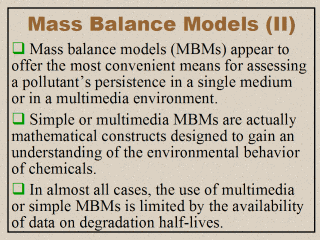| front |1 |2 |3 |4 |5 |6 |7 |8 |9 |10 |11 |12 |13 |14 |15 |16 |17 |18 |19 |20 |review |
 |
Despite their
limitations in practice, mass balance models (MBMs) appear to offer the most
convenient means for estimating a pollutantís persistence in a single medium
or in a multimedia environment. Insofar as overall environmental persistence
is of greater concern, multimedia MBMs are more popular than those gearing
towards persistence in a single medium. MBMs can provide an understanding of
the chemicalís behavior and fate in one or more environmental media. These
models typically link the emission rates to prevailing environmental
concentrations and identify such critical issues as persistence for
excessive times, tendency to bioaccumulate, and the potential to undertake
intermedia transport. Simple and multimedia MBMs are actually mathematical constructs designed to gain a qualitative and quantitative understanding of the environmental behavior of chemicals, which are likely to be present in more than one medium. Such models subdivide the environment into a number of compartments which each are assumed to have homogeneous characteristics and chemical concentrations. The models then calculate the chemicalís distribution pattern within that simplified system. These models thus integrate information on multiple and interacting processes of partitioning, transport, and transformation into a comprehensive and yet comprehensible picture of a chemicalís fate in a specific medium or the environment. In all cases, the use of simple or multimedia MBMs is often limited by the availability of data on degradation half-lives. For students interested in this type of modeling, they should start with the textbook by Mackay (2001), and with the work by Wania and Mackay (2000) on comparing the overall persistence values calculated by various multimedia models. |